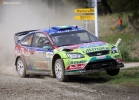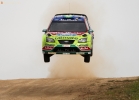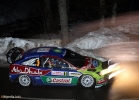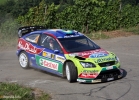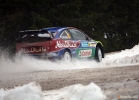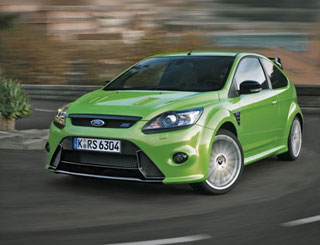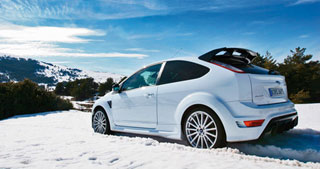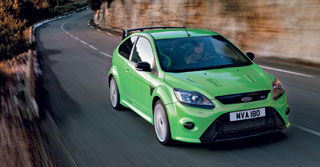Test Drive Ford Focus RS since 2008 Hatchback
Sushing Test: Ford Focus RS, Renault Megane, Mitsubishi Evo X
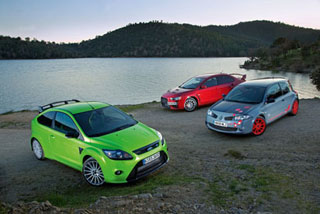 The new Ford Focus RS fits out the power, but is it enough to overcome the uncompromising Renault Megane R26R and all-wheel drive Mitsubishi EVO X?
The new Ford Focus RS fits out the power, but is it enough to overcome the uncompromising Renault Megane R26R and all-wheel drive Mitsubishi EVO X? Sometimes evolution generates real monsters, and it seems that this is exactly this in the class of hot hatchbacks. The newest Focus RS raised the power bar of the power of front-wheelwood sports for the transcendental height, and for him and its today's competitors to come up with a separate genre, because it is no longer lighters in the guise of family small mastrates, but much more serious technique.
And let the presence of Mitsubishi Lancer Evolution X in this test confuse you. There were those times when in the Hierarchy of the EVO sports car along with their sworn rival Subaru Impreza Sti stood at a step above the hot hatchbacks due to the body of the sedan and the rally pedigree. Today, interclative boundaries are erased, and sports buyers often consider EVO as an alternative to hot hatchbecks, and vice versa.
With Renault Megane R26R, too, everything is not so simple. This outcom from the class of hot hatchbacks is trying to break with his past by all means and, I must say, I have quite succeeded. The most extreme megane lost the rear seats and noise insulation, and instead I received plastic windows, safety frame, titanium exhaust system and Extreme Toyo Proxes R888 tires. On the Internet site Toyo, these tires are listed in the Motorsport section, and in the description of the model there is a warning of increased caution when moving along a wet road due to restricted resistance to aquaplaning. As they say, comments are superfluous.
What is the focus?
Fortunately, my colleagues did not fall under the rain on the road to the south of France, where I waited for them on Focus RS, but without this, their way was not easy. The vorapny EVO demanded a refueling almost every half hour, and the damaged Renault stereo gear caressed the driver's hearing of the tires and the engine.
 In Ford, they argue that the owner of Focus RS do not threaten such suffering. This is RS, "says the Chief of the Sports Department of Yost Kapito, - but it remains Focus. RS is built on the basis of Focus ST - one of the best hot hatchbacks on the market. The novelty almost completely borrowed from the younger model of the salon (with the exception of the details of the design and new seats, which perfectly fix the body), and even the steering wheel remained the same, but the KP lever became shorter (a little changed and the insides of the gearbox). Front-wheel drive, contrary to expectations, did not give way to full, and under the hood, RS settled forced to 305 hp. Version of the 2.5-liter turbopter from ST. The work on the motor was not limited to reprogramming of the brain - it received new pistons, camshafts and rods, as well as a more powerful turbine and other attached equipment.
In Ford, they argue that the owner of Focus RS do not threaten such suffering. This is RS, "says the Chief of the Sports Department of Yost Kapito, - but it remains Focus. RS is built on the basis of Focus ST - one of the best hot hatchbacks on the market. The novelty almost completely borrowed from the younger model of the salon (with the exception of the details of the design and new seats, which perfectly fix the body), and even the steering wheel remained the same, but the KP lever became shorter (a little changed and the insides of the gearbox). Front-wheel drive, contrary to expectations, did not give way to full, and under the hood, RS settled forced to 305 hp. Version of the 2.5-liter turbopter from ST. The work on the motor was not limited to reprogramming of the brain - it received new pistons, camshafts and rods, as well as a more powerful turbine and other attached equipment. Changes affected the body. Wings with extended wheeled arches hide an increase in 40 mm kola, the slots in body panels help more efficiently cool the engine, and the elements of the aerodynamic plumage (front spoiler, the rear diffuser and anti-car) create additional clamping force. True, as far as it is great, the Ford does not specify, so that the wonders from the aerodynamics of Focus RS should not wait.
Snob clung to Earth RS (he 20 mm below ST) will seem carticature on a sports Ford, which you can not say about Renault. The R26R dark gray color painted with a carbon hood and red wheels looks more seriously and looks like a real racing apparatus. And even such an important attribute of a sports car, like exhaust pipes, MEGANE is deprived of an outpatch - in contrast to demonstratively wide swells of exhaust on RS.
And what about Mitsubishi EVO X? Against the background of evil Ford and Renault, it seems to be almost an ordinary car, although the technical filling is also very serious here. The two-liter EVO turbo engine develops 295 hp, yielding Focus only 10 horses. Megane at first glance is much weaker - only 230 hp, but this is a deceptive impression. With a mass of 1230 kg
 this car is 125 kg easier than standard R26, and Focus and Evo it wins more than 237 and 330 kg, respectively.
this car is 125 kg easier than standard R26, and Focus and Evo it wins more than 237 and 330 kg, respectively. While my colleagues rushed throughout France on Mitsubishi and Renault, I managed to get acquainted with Focus RS. From the very first minutes, the car struck me with his unexpectedly noble act. The suspension from RS is noticeably tougher than the ST (rear - by 40%!), But this does not interfere with the car perfectly smoothing the pavement flaws. My surprise was replaced by delight, when it turned out that the rigidity of transverse stability stabilizers in RS is the same as the rally Focus WRC 2006 in the asphalt display.
In powerful front-wheel drive cars, the so-called parasitic winding of the front wheels is inevitable, and Focus RS, despite all the tricks of Ford engineers, is not deprived of this shortage. Developed specifically for RS Front suspension Revoknuckle made it possible to reduce the distance between the axis of rotation of the wheel and its geometric center. The smaller this distance, the less the so-called shoulder running, that is, the lever on which the very power acts, because of which the steering wheel of the front-wheel drive car strives to escape from the hands when the gas pedal is pressed. The REVOKNUCKLE system allows you to reduce this distance of about two thirds. That's the whole focus. By the way, a similar design is used on Megane R26R.
The engine and transmission RS differ in the same delicacy as the suspension. Despite the high degree of engine forcing, it remains soft and stopped, although the hissing of the turbine and cotton exhaust you might think that under the hood is hidden by an indomitable monster. At least when I parked Focus RS next to Megane R26R and EVO X, the sound led to the delight of my colleagues, waiting for me on the mountain pass of Kol De Vens.
On high
Here, in the Alps, any road will force the heart of a sophisticated driver to fight, but even among this magnificence, we found something special - monte-carloral rally. For 5 km, the highway in the devilish dance loops on mountain slopes, demanding from the driver and its car maximum self-dedication.
After a series of races there and back, I come to the conclusion that EVO X, despite its all-wheel drive transmission, causes more complaints in these specific conditions. His creators clearly moved with sports. The pleasure of excellent clutch with a coating, impressive dynamics and magnificent reactions to the steering wheel spoils a rigid suspension. In the desire to tell the driver about all the features of the asphalt under the wheels of EVO unpleasantly shuddered on the pins and jumps on the irregularities. Yes I.
 steering with all its sharpness, accuracy and competently selected effort is not pleased with feedback. Analyst-generation EVO reference in this respect exceeds the current model.
steering with all its sharpness, accuracy and competently selected effort is not pleased with feedback. Analyst-generation EVO reference in this respect exceeds the current model. To complete the uncomplicable abilities of Mitsubishi, you need a racing track. Only there you can afford to enter the turn on braking, provoke the rear axle drift and give full gas, straightening the trajectory. But on the usual road, such tricks are too complex and unsafe, and without them, the charm of EVO X will rake racing. Unassuming interior (although the seats are very comfortable), the boring sound of the motor (but a very clear mechanism of KP) and the brake pedal complement the picture.
Megane R26R is not as fast as EVO X, on a straight line, but it is not inferior to it in terms of handling, and something is superior. Renault soft suspension cannot be called, but with irregularities it copes more efficiently than Evo: where the tires are cut off from asphalt on Mitsubishi, R26R retains contact with the coating. The racing tires will undoubtedly contribute to the case, as well as low unsappressible masses. Thanks to this, the R26R wheels react faster to the profile of the road and transmit less fluctuations on the body.
Modern Renaults are not distinguished by the stunning informativeness of the steering, and R26 is no exception. Despite the very obedient chassis, the steering wheel is too light here, although compared to other models of the brand, it allows you to more accurately direct the machine to the desired trajectory. The two-axle design of the front suspension reduces parasitic infringements under the charge, but even additional help of the differential of high friction, which juggles the torque between the front wheels, does not allow to completely eliminate the lungs of steering.
Tires in which R26R wage provide an impenetrable grip on dry asphalt. Perhaps even EVO does not hold the road as good as Renault. Only with rough operation, the gas pedal at the outlet of the magnifier can be disrupting the front wheels into sliding, provoking insufficient turning.
Under the evil roar of the titanium exhaust system, R26R lightningly accelerates and storms turns. This is undoubtedly one of the best front-wheel drive cars in history. If I were sentenced to the front drive for a whole life, then I would change this megane except for the old Honda Integra Type R. or on a new Focus RS?
Quickly and good
After Renault Ford, at first it seems the car is a completely different breed. It is clearly heavier and solid, but the most powerful engine quickly negates all suspicions in RS's nervousness. The acceleration pairs are enough to come to the conclusion that Focus is the fastest car in this trio. And the front wheels are surprisingly easily cope with Nachis 305 horses. Only on I gear, there is a small slip, and for some reason parasitic infringements, for some reason, no longer appear when the steering wheel is rotated, and in the okoloneal zone. On RS of the first generation there was a differential of high friction, thanks to which the car could literally tighten into a turn with a gas pedal. The new RS is not capable of this, and the differential is increasing here the return movement of the steering wheel, so the ram has to return to the zero position when leaving the rotation. Focus steering is heavier than Megane, and it favorably affects his informativeness. In addition, the help of the steering amplifier here can be adjusted here: in the Comfort mode, the ram becomes as easy as possible, and when switching to Normal and further in Sport, the effort on the steering wheel and, as a result, feedback is increasing.
 If Megane's controllability spines the front wheels and the behavior of the machine depends only on them, then Focus in turns seems to rotate around the vertical axis passing through the center of the car. Therefore, on R26R provoke the slide of the front wheels is much easier than the rear skid, and RS has a more neutral controllability. Ford representatives have not yet published the RS time on Nürburgring, but argue that the novelty passes the range of Renault, the result of which is 8 minutes 17 seconds. It looks like the truth, as the engine power on the northern loop is very important, and, despite the exclusively chassis chassis Megane, on a straight Focus is significantly faster. With poor asphalt RS also copes more than worthy. And although the Ford wheel, unlike Renault, does not seem that the car literally sticks to the road, Focus does not storm irregularities like Megane, and skillfully dissolves them in the depths of the suspension due to the well-selected stiffness of the shock absorbers. In general, the RS chassis, of course, is not so informative, like R26R, but for high-speed driving it is not a hindrance.
If Megane's controllability spines the front wheels and the behavior of the machine depends only on them, then Focus in turns seems to rotate around the vertical axis passing through the center of the car. Therefore, on R26R provoke the slide of the front wheels is much easier than the rear skid, and RS has a more neutral controllability. Ford representatives have not yet published the RS time on Nürburgring, but argue that the novelty passes the range of Renault, the result of which is 8 minutes 17 seconds. It looks like the truth, as the engine power on the northern loop is very important, and, despite the exclusively chassis chassis Megane, on a straight Focus is significantly faster. With poor asphalt RS also copes more than worthy. And although the Ford wheel, unlike Renault, does not seem that the car literally sticks to the road, Focus does not storm irregularities like Megane, and skillfully dissolves them in the depths of the suspension due to the well-selected stiffness of the shock absorbers. In general, the RS chassis, of course, is not so informative, like R26R, but for high-speed driving it is not a hindrance. However, as practice shows, speed and pleasure - not identical concepts. Focus can proudly carry the title of the fastest front-wheel drive car in the world, and among the 4-seater hot hatchbacks, he is probably the best. But if you need the best car for pleasure, you will have to come to terms with the fact that it will be 2-beddable - such as Megane R26R.
 Specifications Ford Focus RS
Specifications Ford Focus RS Gabarites, mm.
4402x1842x1497
Curb weight, kg
1467
engine's type
gasoline L5 with turbocharged
Working volume, cube. cm
2522
Max. Power, hp / rpm
305/6500
Max. Moment, nm / rpm
440/2500-4500
Transmission
mechanical 6-speed
Drive unit
front
Max. Speed, km / h
263
Acceleration time 0100 km / h, with
5,9
Fuel consumption (medium), l / 100 km
9,4
 Specifications Renault Megane R26R
Specifications Renault Megane R26R Gabarites, mm.
4505x1810x2650
Curb weight, kg
1635
engine's type
gasoline L4 with turbocharged
Working volume, cube. cm
1998
Max. Power, hp / rpm
295/6500
Max. Moment, nm / rpm
366/3500
Transmission
mechanical 5-speed
Drive unit
full
Max. Speed, km / h
240
Acceleration time 0100 km / h, with
5,4
Fuel consumption (medium), l / 100 km
10,4
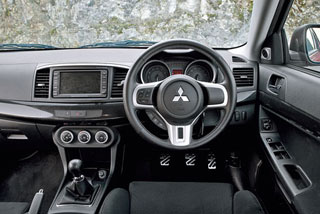 Specifications Mitsubishi EVO X
Specifications Mitsubishi EVO X Gabarites, mm.
4228x1777x2617
Curb weight, kg
1230
engine's type
gasoline L4 with turbocharged
Working volume, cube. cm
1998
Max. Power, hp / rpm
230/5500
Max. Moment, nm / rpm
310/3000
Transmission
mechanical 6-speed
Drive unit
front
Max. Speed, km / h
237
Acceleration time 0100 km / h, with
6,0
Fuel consumption (medium), l / 100 km
8,5
Matt Praior.
Photo Stan Phapior
Haymarket Magazines Ltd, AutoCar
A source: Magazine "Autopanoram"

